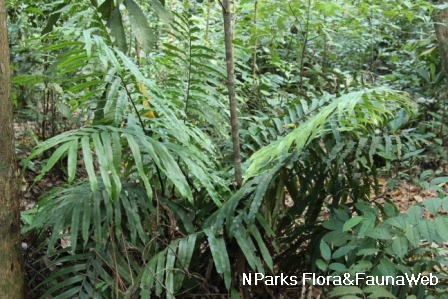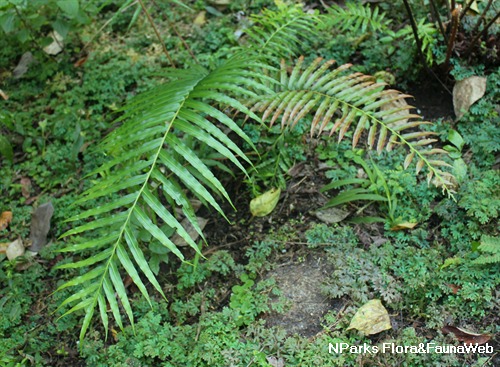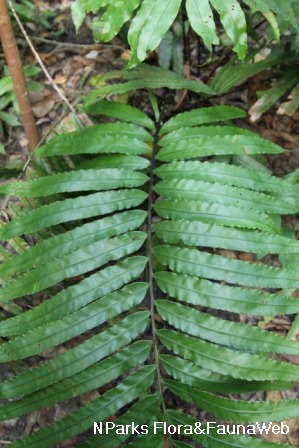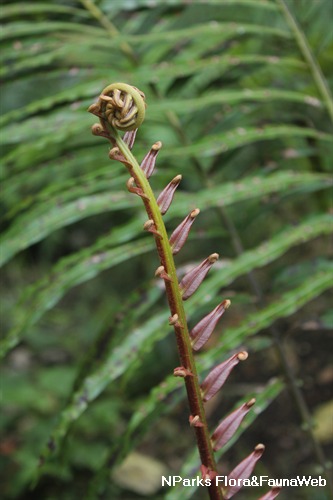
Back
Blechnopsis orientalis (L.) C.Presl
| Family Name: | Blechnaceae |
| Synonyms: | Blechnum orientale |
| Common Name: | Centipede Fern, Paku Lipan, 乌毛蕨 |
Blechnopsis orientalis or Centipede Fern is a terrestrial fern native to Singapore. It has reduced leaflets along the leaf stalks and pinnate fronds gradually narrowing to a long tip. The sori produced along the sides of the midrib tends to cover the midrib at maturity. Centipede fern is a sun-loving fern of varying size as opposed to a similar species - Blechnopsis finlaysoniana which thrives in a shaded environment, consistent in its size.
Name
Classifications and Characteristics
| Plant Division | Ferns & Lycophytes (Non-Seed Vascular Plants) (Fern) |
|---|---|
| Plant Growth Form | Herbaceous Plant |
| Lifespan (in Singapore) | Perennial |
| Mode of Nutrition | Autotrophic |
| Maximum Height | 60 cm |
| Maximum Plant Spread / Crown Width | 60 cm |
Biogeography
| Native Distribution | Tropical Asia. From India, southern Japan, throughout Southeast Asia to the Pacific and Australia. |
|---|---|
| Native Habitat | Terrestrial (Primary Rainforest, Secondary Rainforest) |
| Preferred Climate Zone | Tropical |
| Local Conservation Status | Native to Singapore (Least Concern (LC)) |
Description and Ethnobotany
| Growth Form | It is a terrestrial fern with indefinite growth in its length, occasionally forms a tree fern of up to 2 m tall. |
|---|---|
| Foliage | Fronds have thick leaf stalks covered in scales, bearing reduced leaflets along its length as auricles. The fronds are upright, narrowly elliptic to drop-shaped, pinnate, variable in size, each contain between 6 - 70 pairs of leaflets or more. The leaflets are narrowly elliptic to linear, gradually narrowing to a long tip. The juvenile fronds are pinnatifid, lower lobes have a round to obtuse tip. |
| Reproductive Parts - non-flowering plant | The sori produced on the underside are linear, continuous, narrow about 1 mm wide on both sides of the midrib, often covering the midrib at maturity. |
| Others - Plant Morphology | Rhizomes are thick and upright, usually short about 6 - 20 cm and may form a trunk of up to 2 m tall, densely covered in shiny reddish-brown linear to narrowly elliptic scales. |
| Habitat | Occurs in a range of habitats, creek banks, waterfalls, seepage areas, swamps, open or exposed areas at the margins of lowland, upland tropical and subtropical forests. <1> <2> |
| Similar | Blechnopsis orientalis and Blechnopsis finlaysoniana show similarities in apperance. B. orientalis is a sun-loving fern, of variable size. The leaflets narrow gradually to a long tip with a box-shaped base. While B. finlaysoniana prefers a shaded environment, consistent in its size. The leaflets narrows abruptly to a long tip with a wedge-shaped base. <1> |
| Cultivation | It can be propagated by spores. |
| Etymology | Genus Blechnum comes from the Greek word "βλῆχνον", which means "for a fern". Species orientalis means from the East or Oriental region. |
Landscaping Features
| Landscaping | It is suitable for landscaping in parks on open areas or in paritally shaded areas. |
|---|---|
| Desirable Plant Features | Ornamental Foliage |
| Landscape Uses | General, Parks & Gardens, Small Gardens |
Fauna, Pollination and Dispersal
| Seed or Spore Dispersal | Abiotic |
|---|
Plant Care and Propagation
| Light Preference | Full Sun, Semi-Shade |
|---|---|
| Water Preference | Moderate Water, Little Water |
| Plant Growth Rate | Moderate |
| Rootzone Tolerance | Moist Soils |
| Propagation Method | Spore |
Foliar
| Foliage Retention | Evergreen |
|---|---|
| Mature Foliage Colour(s) | Green |
| Mature Foliage Texture(s) | Leathery |
| Prominent Young Flush Colour(s) | Orange, Red |
| Foliar Type | Compound (Odd-Pinnate) |
| Foliar Shape(s) | Non-Palm Foliage (Elliptical, Linear, Ovate) |
| Foliar Margin | Entire |
| Foliar Apex - Tip | Acuminate |
| Foliar Base | Rounded / Obtuse, Truncate / Square |
Non - Foliar and Storage
| Stem Type & Modification | Herbaceous |
|---|---|
| Root Type | Underground (Fibrous Root) |
| Specialised Storage Organ(s) | Underground (Rhizome) |
References
| References | <1> Nooteboom, H.P. (2012). Blechnum. In: Nooteboom, H.P. (ed.) Blechnaceae. Flora Malesiana, ser. 2, Pteridophyta, vol. 4, pp. 21-24. Leiden: Rijksherbarium <2> Tagawa, M. & Iwatsuki, K. (1988). Flora of Thailand, vol. 3(3), pp. 298. Bangkok: The Forest Herbarium, Department of National Parks, Wildlife and Plant Conservation. |
|---|
Image Repository
Others
| Master ID | 31149 |
|---|---|
| Species ID | 5542 |
| Flora Disclaimer | The information in this website has been compiled from reliable sources, such as reference works on medicinal plants. It is not a substitute for medical advice or treatment and NParks does not purport to provide any medical advice. Readers should always consult his/her physician before using or consuming a plant for medicinal purposes. |



.jpg)




